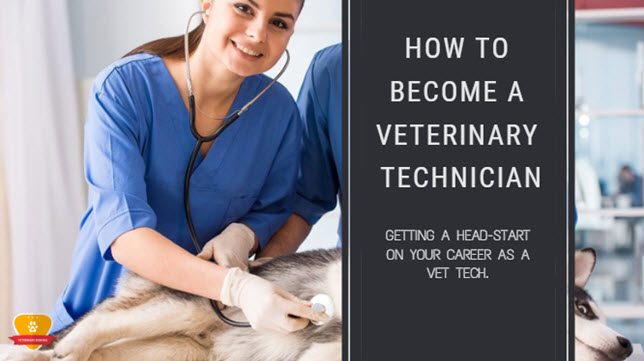To become a veterinarian technician, you need to obtain a degree in veterinary technology or a related field.
Understanding The Role Of A Veterinarian Technician
html
| Responsibilities and Duties | Importance in Veterinary Practice |
|---|---|
| A veterinarian technician plays a crucial role in assisting veterinarians in providing medical care to animals. They perform various responsibilities and duties, such as: | Being an integral part of a veterinary practice, veterinarian technicians hold significant importance: |
| 1. Assisting in animal examinations and treatments 2. Administering medications and vaccines under supervision 3. Collecting and analyzing lab samples 4. Preparing animals for surgeries 5. Conducting dental cleanings and extractions 6. Educating pet owners on proper animal care and medications |
Enhancing efficiency in veterinary clinics Supporting veterinarians in providing quality care Ensuring smooth operations during procedures Facilitating proper communication between veterinarians and pet owners Acting as a compassionate advocate for animals |
Veterinarian technicians require proper education and training to fulfil their roles effectively. They typically complete a two-year associate degree program in veterinary technology, which includes coursework in animal anatomy, pharmacology, diagnostic imaging, and surgical nursing. Some states also require them to pass the Veterinary Technician National Exam (VTNE) to become certified.
Becoming a veterinarian technician can be a rewarding career choice for animal lovers who are passionate about providing medical care and assistance to animals. With their essential skills and qualifications, veterinarian technicians contribute significantly to the overall well-being of animals in veterinary practices.
Essential Education For A Veterinarian Technician
Obtaining the necessary education is crucial for individuals aspiring to become veterinarian technicians. The first requirement is a high school diploma or its equivalent. This serves as the foundation for further education and training in the field. After completing high school, aspiring vet techs typically enrol in a veterinary technology program, which provides them with the essential knowledge and skills required for the profession. These programs cover a wide range of subjects, including animal anatomy and physiology, pharmacology, surgical procedures, and diagnostic imaging. To ensure the quality of education and training, it is important to choose a program that is accredited by a recognized veterinary technology accrediting body.
Upon completion of the veterinary technology program, vet techs may need to fulfil additional requirements depending on their location. Some states or provinces require vet techs to obtain certification or licensure before they can practice. This usually involves successfully passing a certification exam. The exam may be conducted by a state or provincial board or by a national credentialing organization. Getting certified demonstrates that a vet tech has met certain standards of competency and professionalism.
Core Courses In Veterinary Technology Programs
Core Courses in Veterinary Technology Programs:
The education required to become a veterinarian technician includes core courses in various subjects. One of the main courses is animal anatomy and physiology, which focuses on understanding the structure and function of animals’ bodies. It is important for veterinary technicians to have a solid understanding of the different systems within an animal’s body.
Pharmacology and anaesthesia is another essential course in a veterinary technology program. This course covers the study of medications and their effects on animals. Veterinary technicians need to have a thorough knowledge of different drugs and anaesthesia techniques to ensure the safety and well-being of animals during procedures.
Animal nursing and patient care is also a critical course for aspiring veterinary technicians. This course teaches techniques for providing support and care to animals, including administering medications, monitoring vital signs, and managing the overall well-being of patients.
Diagnostic imaging and laboratory procedures are other important subject in veterinary technology programs. This course covers techniques such as X-rays, ultrasounds, and laboratory testing, enabling veterinary technicians to assist in diagnosing and treating animal illnesses and injuries.
Veterinary Clinical Skills Development
Veterinary Clinical Skills Development
Hands-on experience in veterinary clinics and hospitals: To become a veterinarian technician, hands-on experience is essential. Working in veterinary clinics and hospitals provides valuable exposure to various tasks and procedures performed in a clinical setting. It allows technicians to observe and assist in routine check-ups, diagnostic tests, and treatments. This experience not only enhances clinical skills but also helps in understanding the dynamics of a veterinary practice.
Surgical assistance and monitoring: One crucial aspect of a veterinarian technician’s education is acquiring skills in surgical assistance and monitoring. Technicians are trained to assist veterinarians during surgeries, including preparing surgical instruments, monitoring anesthesia, and ensuring the well-being of the animal throughout the procedure.
Emergency and critical care procedures: Veterinary technicians are often required to handle emergency and critical care situations. This involves learning how to respond to emergencies, triaging patients, providing first aid, administering medications, and assisting with life-saving procedures under stressful conditions.
Veterinary Medical Knowledge
When pursuing a career as a veterinary technician, it is essential to possess a strong foundation of veterinary medical knowledge. This entails a deep understanding of diseases and conditions management, veterinary pharmacology and medication, as well as radiology and diagnostic imaging interpretation.
Veterinary technicians play a crucial role in the healthcare of animals by assisting veterinarians in diagnosing and treating various medical conditions. They must be well-versed in the management of diseases and conditions, ensuring accurate observation and assessment of symptoms, and providing appropriate care.
Furthermore, a comprehensive understanding of veterinary pharmacology and medication is essential. Veterinary technicians must be adept at administering medications, understanding dosage guidelines, and recognizing and managing potential side effects.
Radiology and diagnostic imaging interpretation is another crucial aspect of a veterinary technician’s role. They must be skilled in operating imaging equipment, interpreting x-rays and scans, and identifying abnormalities or injuries.
Practical Experience And Externships
Practical experience and externships play a crucial role in the education required to become a veterinarian technician. Gaining hands-on experience through externships allows aspiring vet techs to apply their theoretical knowledge in real-world settings. By working alongside experienced professionals in the field, students have the opportunity to observe and participate in various veterinary procedures.
Externships provide valuable learning experiences for vet tech students, as they can witness and assist with surgeries, diagnostic tests, and treatments. This practical exposure helps them develop essential skills and competencies, such as animal handling, medical record keeping, and laboratory techniques.
Moreover, externships allow students to interact with different species of animals, including domestic pets, farm animals, and wildlife. This diverse experience broadens their understanding of veterinary medicine and prepares them for a variety of scenarios they may encounter in their future careers.
Professional Certifications And Licensing
National and state-level certification requirements: To become a veterinarian technician, individuals must meet certain certification requirements. These requirements vary depending on the country and state in which the individual intends to practice. National-level certifications are available in some countries, along with state-level certifications that may be required.
Examinations and eligibility criteria: In order to obtain certification, candidates typically need to pass an examination that assesses their knowledge and skills in veterinary technology. Eligibility criteria may include completing an accredited veterinary technology program, acquiring a certain number of hours of practical experience, and passing a background check.
Renewal and maintenance of credentials: Once certified, veterinary technicians often need to renew their credentials periodically. This may involve completing continuing education credits and staying updated on the latest developments in the field. Failure to maintain credentials may result in loss of certification or the need to retake examinations.
Enhancing Your Career As A Veterinarian Technician
html
Continuing education and professional development opportunities: As a veterinarian technician, it is crucial to stay updated on the latest advancements in the field. Engaging in continuing education programs and professional development opportunities is an excellent way to enhance your knowledge and skills. These may include attending workshops, conferences, and seminars, and obtaining certifications relevant to your specialization.
Pursuing specialization in specific veterinary areas: Specializing in a specific area of veterinary medicine can open up new doors for your career as a veterinarian technician. By focusing on a particular field, such as anesthesia, dentistry, emergency care, or laboratory diagnostics, you can develop expertise and offer specialized services. This can lead to more job opportunities and increased earning potential.
Networking and professional connections: Building a strong network of professional connections can significantly benefit your career as a veterinarian technician. Connecting with veterinarians, other veterinary technicians, and professionals in related fields can provide valuable insights and opportunities for collaboration. Attend industry events, join professional organizations, and engage in online forums and social media groups to expand your network and stay connected with the latest industry trends.

Credit: www.allalliedhealthschools.com
Conclusion
Becoming a veterinary technician requires a combination of education and hands-on experience. The first step is to complete a vet tech program accredited by the AVMA. This training provides the necessary knowledge and skills to work effectively in the field.
Additionally, gaining practical experience through internships or volunteering is crucial for a successful career. Continuous learning and staying up-to-date with advancements in veterinary medicine is also essential. So, if you have a passion for animals and a dedication to providing quality care, the education and training to become a veterinary technician is well worth it.







